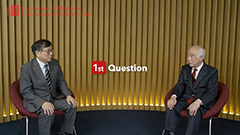Increasing global needs for earthquake disaster risk reduction

The risk of earthquakes exists all over the world. Today in Japan, we are working on earthquake countermeasures based on the idea that we should aim to prevent damage not only to lives but also to buildings, so that social functions can be maintained during the case of disaster.
Recently, because of many earthquake occurrences around the world, the interest in earthquake disaster risk reduction is increasing in each country. Under such circumstances, today in Japan, we are working on earthquake countermeasures based on the idea that even if a large-scale earthquake occurs, we should aim to prevent damage not only to lives but also to buildings, so that their continuous usability and social functions can be maintained during the case of disaster.
Japan, as a country with a lot of earthquake disasters, we created JICA-Net multimedia-based learning material, “Japan's Experience in the Earthquake and Seismic Sector” (YouTube, external link), as an effective tool to convey how Japan transformed its way of thinking through the experience and lesson-learnt from the past disasters. It introduces the current technical countermeasures in a large-scale earthquake to students in developing countries with a high risk of earthquake, those involved in JICA Technical Cooperation projects, JICA trainees participating in the disaster prevention courses. We intend to promote pre-disaster investment for disaster risk reduction in countries with high earthquake risk through the material.
Japan’s earthquake disaster risk reduction to “prevent damage not only to lives but also to buildings”
Almost 10% of human-felt earthquakes, including damaging ones, take place in and around the archipelago of Japan. Throughout its long history, Japan has been making efforts to develop a strong disaster-resilience society.
In the material, we invited Tokyo Institute of Technology’s professor Emeritus WADA Akira, who has led Japan’s earthquake disaster risk reduction, especially earthquake-resistant buildings, and discusses Japan’s way of thinking about earthquake disaster risk reduction in a dialogue with YOKOI Toshiaki, JICA senior advisor.
Referring to the transformation and process of earthquake-resistant buildings based on Japan’s actual disaster experiences, the material introduces the importance of the idea of “prevent damage not only to lives but also to buildings” and “Seismic isolation structure” which is one of the technologies to achieve this idea.

In the material, we invited Tokyo Institute of Technology’s professor Emeritus WADA Akira and discusses Japan’s way of thinking about earthquake disaster risk reduction in a dialogue with YOKOI Toshiaki, JICA senior advisor.

In the second half, the material introduces JICA’s technical cooperation projects and training projects about earthquake disaster prevention in each country in the world.
In the second half, by introducing JICA’s technical cooperation projects and training projects about earthquake disaster prevention, it shows the importance of implementing technical cooperation in a manner that considers the circumstances of different countries, not applying Japan’s technologies, legal systems, or standards.
Regardless of its frequency, because a large-scale earthquake can cause great damage when it occurs, we intend to emphasize that making an effort to reduce disaster risk in advance is necessary to create a society in which not only current generations but also future ones can live safely.
To create a safe and secure society for future generations
Although the material intends to be used mainly by those involved in JICA technical cooperations to screen in trainings and events, for meetings with counterparts, study meetings, and so on, the contents is widely available to anyone who is interested.
We hope that the material will convey the technology and lesson-learnt from past disasters, and the importance of pre-disaster investment for disaster risk reduction to maintain social functions and contribute to the realization of a society where future generations can live safely and securely.
YAMAUCHI Shino
JICA Global Environment Department
*The Material(s) mainly applied
Japan's Experience in the Earthquake and Seismic Sector
Today in Japan, mainly regarding critical public buildings such as disaster prevention/management facilities, hospitals, schools, etc., we are working on earthquake countermeasures based on the idea that even if a large-scale earthquake occurs, we should aim to prevent damage not only to lives but also to buildings, so that their continuous usability and social functions can be maintained. The video shows how Japan recognized such way of thinking through the experience and lesson-lerant from the past disasters and introduces the current technical countermeasures for a large-scale earthquake.
◆JICA Lecture Series of Japanese development experience to date: in line with JICA Global Agenda, cooperation strategies by development issues This video series provides a comprehensive summary, by development issue, according to the lineup of JICA’s cooperation strategy called the “JICA Global Agenda.”
These video lecture shall be widely disseminated to JICA chair participants, trainees, JICA staff, and other interested parties. To have them learn about the process by which Japan has solved development issues.




scroll